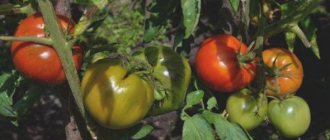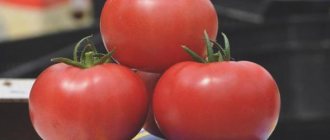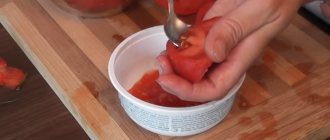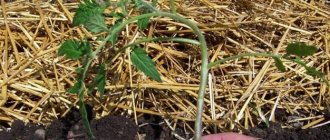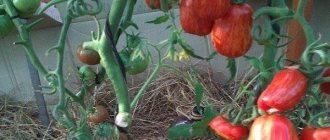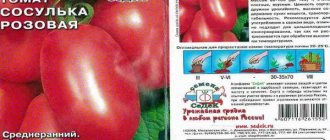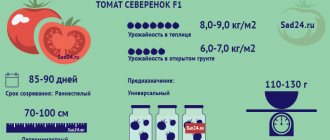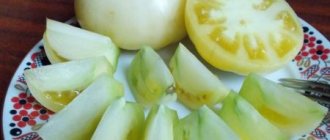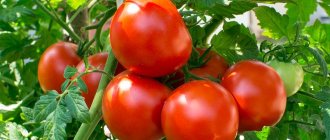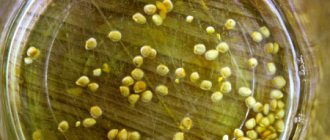When choosing tomatoes to grow on their plot, vegetable growers try to choose a variety with the best characteristics. The main requirement is high yields at minimal costs. Tall tomatoes have these properties. But breeders presented gardeners with a valuable gift - semi-determinate varieties. Conventional indeterminate varieties reach a height of 2 m or more, so caring for plants and harvesting in a home greenhouse is not always convenient. And semi-determinate varieties have well-defined advantages over conventional varieties. These types include the Spasskaya Tower tomato, a description of the variety and the main characteristics of which we will consider in the article.
Advantages of a medium-growing variety
To understand how profitable it is to grow tomatoes of the Spasskaya Tower variety, you need to look at the reviews of vegetable growers. The most important qualities that made the variety popular and in demand are:
- Mid-early ripening period. A very convenient option for tomatoes. Ripe fruits are ready for tasting 95-115 days after the first shoots appear. At this time, other vegetables also ripen, which makes it possible to diversify the diet and the amount of preparations.
- Versatility of cultivation. The Spasskaya Tower tomato variety is intended for cultivation in open ground and in greenhouses. Farmers note that the main characteristics of tomatoes do not depend on the growing method.
- Space saving. The height of an adult plant reaches 150 cm, each bush simultaneously produces up to 10 bunches of juicy tomatoes. Therefore, even a small number of planted Spasskaya Tower tomatoes can satisfy the needs of an entire family over the course of a season.
- Super-yielding. Compliance with the requirements of the variety's agricultural technology allows you to obtain a tomato harvest within six months. When grown in a greenhouse - all year round. According to reviews from gardeners, from 1 sq. m of area they harvest 30 kg or more of tasty, nutritious Spasskaya Tower tomatoes.
- Resistance to changes in climate and growing conditions. This is an important characteristic of the Spasskaya Tower tomato variety. Even sudden frosts, a sharp drop in temperature and a limited amount of light do not reduce the yield of a medium-sized variety.
- Resistance to crop diseases. The description of the Spasskaya Tower tomato indicates that the variety is not susceptible to fusarium, cladosporiosis, root-knot nematode, and TMV. This is due to the unique structure of the bush and its height. Half of the nodes do not form stepsons. Thanks to this, the plants receive light evenly, are well ventilated, are rarely damaged by pests and do not get sick.
- Excellent taste and beneficial properties of the fruit. According to reviews from vegetable growers, half of the tomatoes of the Spasskaya Tower f1 variety reach a weight of up to 0.5 kg. And under favorable growing conditions and good care, all fruits have this weight.
- Excellent transportability and keeping quality of tomatoes. It is an advantageous variety for commercial cultivation.
- Versatility of use. The fruits of the variety are excellent for fresh consumption, canning, making salads, purees, juices and sauces.
Important! Tomato bushes must be supported with supports so that the stems do not break under the weight of the fruit.
Hybrid characteristics
To find out how good this unique tomato is, you need to carefully study its characteristics and description of the variety. The hybrid Spasskaya Tower F1, which belongs to the medium-early fruit ripening time, can be placed in open ground or a greenhouse. The variety was bred for the risky farming zone, which means it easily tolerates temporary temperature drops to values close to zero and insufficient lighting.
Determinate type tomato bushes:
- in greenhouse conditions the stem grows up to 1.5 meters;
- in a garden bed, the stem rarely exceeds 1 meter in length.
Stepchildren are not formed in every leaf axil, which makes the bushes not thickened.
The fruits ripen together, which puts a lot of stress on the stem, which may not withstand it or break. To support the plants, they place supports and tie up tomato shoots.
The shape of the fruit is round, smooth, slightly elongated, the color is red with a pink tint. Each fruit in the clusters weighs 200 g or slightly less. The outer shell of tomatoes is strong, which prevents them from cracking.
The taste of the fruit is pleasant, the pulp is characterized by increased density. These tomatoes are readily eaten fresh, salted, and used to produce the following products:
- lecho;
- ketchup;
- tomato paste.
Tomato plantings can tolerate:
- temperature fluctuations;
- low light;
- short-term cold spells.
The variety is resistant to:
- viral diseases;
- nematode;
- olive spot.
Advantages and disadvantages
In order for the list of characteristics to be complete, let’s consider the pros and cons of a tasty hybrid.
Advantages of the variety:
- the ability to obtain maximum yield in a minimum area;
- excellent taste and nutritional quality of tomato fruits;
- resistance to viral infections and pest invasions;
- early ripening, allowing for compact harvesting;
- no dependence on the degree of illumination;
- stable development under climatic fluctuations;
- long fruiting period.
There are much fewer disadvantages, and against the background of the advantages they are perceived as features of care. All of them are displayed in the description of the Spasskaya Tower tomato variety:
- weak roots, which necessitates tying plants to trellises;
- inability to independently harvest hybrid seed material.
It should be said that strict compliance with agrotechnical requirements guarantees a high yield of tasty tomatoes.
Features of growing in open ground
Most often, tomatoes are grown in open ground. The fruits from such bushes are the most delicious (from the point of view of our taste buds). A study of the organoleptic properties of tomatoes shows that home-grown fruits from the garden are richer in nutrients and are many times healthier. Thus, the level of lycopene (an antioxidant) in such tomatoes is high, which has a positive effect on the functioning of the cardiovascular system.
Watering
Tomatoes should be watered generously when planting in the ground. Then water as the soil becomes dry (until the crop ripens). Each plant will need about 12 liters of water weekly. When watering, moisture should not fall on the leaves; only the root zone should be carefully moistened. Therefore, small private farms practice installing plastic bottles on the garden bed.
To do this, cut off the bottom of the bottle and make several side holes. Dig the bottle upside down near the tomato and pour water into it. The soil will accept moisture from the bottle, and the plant's roots will extract it from there. Thus, the problem of excessive moisture or intensive watering with leaching of soil from under the root will disappear.
Find out how to water tomatoes in a greenhouse.
Feeding
Fertilizers are applied to moist soil approximately every 14-20 days. If you watered the soil today, then you need to apply fertilizer a few hours later - after some of the water has been absorbed.
The approximate fertilizer application schedule is as follows:
- 10 days after transplanting tomatoes into the ground, they need to be fertilized. For organic fertilizers, use a mixture of mullein, which is diluted in a ratio of 0.5 kg per 10 liters of water. Pour the solution into the root zone, 0.5 liters for each bush. Additionally, a solution of nitrophoska is applied under the root - in a dosage of 15 ml of fertilizer per 10 liters of water. For each bush - 0.5 liters of solution.
- 20 days after the first feeding, the second is carried out. Feeding composition: organic fertilizers - mullein, mineral fertilizers - superphosphate and potassium sulfate. Both microelements are dissolved in water, 1 tablespoon per 10 liters of water, and 1 liter of solution is added to each bush.
- After another 2 weeks, feed the plants again with nitrophoska in the same dosage.
- And after another 2 weeks - re-apply superphosphate.
Important! Do not exceed the drug limits indicated on the packages. An excess of minerals is no less harmful than their deficiency.
Stepsoning
Side shoots developing in the leaf axils must be plucked off in time so that the plant spends energy and nutrients only on fruit growth. Otherwise, there will be many beautiful leaves, but few fruits. This process is called stepsoning. When pinching, the main stem and stems with tomato trusses are left. Small shoots are broken off with your fingers, large shoots are cut off with pruning shears.
The procedure is carried out as needed. It is equally important to promptly stop the growth of plants by pinching the tops. For tomatoes in the ground, 5-7 bunches of fruit are enough. Further growth of the plant is impractical.
An effective way to feed is yeast.
Soil care
In the root zone, the soil should always remain loose. Therefore, it is weeded 2-3 days after abundant watering. The depth of loosening is 8-10 cm. Simultaneously with loosening, emerging weeds are removed.
When the plant has grown into a good bush, the soil around the trunk is hilled up. This improves the condition of the root system, enhances the growth of lateral roots and allows the soil to warm up better. You need to hill up twice. The first time - 3 weeks after planting, and the second - another 2 weeks after the first.
Did you know? The first tomatoes that came to Europe were yellow. This is how they acquired their name “pomme d'ore” -
"
Golden Apple
"
.
Organic mulch is straw, grass, leaves, sawdust. It will help retain moisture in the root zone and provide warmth to the roots; the soil underneath will warm up. The layer size is about 10-15 cm. Mulch can also prevent the appearance of weeds in the beds.
Tying up a bush
Tomatoes “Spasskaya Tower f1” begin to be tied as the bush develops. This is due to the weight of the fruit: the greater the weight, the greater the load on the trunk. Tying helps to transfer part of the weight to the support. Since the height of the variety can reach 1.5 m, it is better to use trellis tying.
Stands are installed at different ends of the row, and wire is pulled on them at a height of 0.4-0.5 m, 0.7-0.8 m and 1.2-1.4 m, to which the emerging bushes will be tied. You can also try tying the bushes to stakes if the bushes are less than 1 m tall.
Preventative treatment
In order for the plants to produce maximum yield and be invulnerable to pests, it is advisable to follow a number of measures:
- take into account crop rotation and do not plant tomatoes in the same area every year:
- Before planting, always take into account the acidity of the soil and know what are the ways to neutralize it;
- disinfect the soil with hot water from pests and putrefactive bacteria;
- destroy all infected plants and do not leave organic residues in the beds over the winter;
- do not water the plants if the soil is moist;
- control the appearance of pests using insect traps and begin combating them in a timely manner;
- when purchasing seeds, pay attention to what diseases the variety is resistant to;
- Before planting seeds, disinfect and harden them.
Nuances of agricultural technology for a medium-sized variety
Particular attention should be paid to preparing the soil and the place for planting Spasskaya Tower tomatoes. According to gardeners, it is more convenient to divide the preparatory work before planting the Spasskaya Tower tomato into 2 stages. The variety is demanding on soil fertility, so without adding organic matter it will not be possible to get a good harvest. Compost, humus or peat are added to the soil during autumn digging. At the same time, phosphorus and potassium fertilizers are applied so that by the time the tomato seedlings are planted, they dissolve in the soil.
The second stage of soil preparation occurs in early spring. At this time, nitrogen fertilizers are applied for the growth of green mass.
If the autumn stage was missed, then it is postponed to the spring. The main thing is to complete it a month before the scheduled time for planting tomato seedlings.
In their reviews, vegetable growers note that the Spasskaya Tower tomato variety responds well to the ecological type of fertilizing the soil with green manure. Mustard or rye are suitable for nightshades.
How to grow tomatoes
After 2 months, the seedlings are ready to be transplanted to a permanent location.
Beds for tomatoes are chosen in a sunny place protected from drafts. Planting pattern: 50 cm – distance between seedlings, 50 cm – between rows. For 1 sq. m place no more than 4 seedlings.
Plant the tomato in pre-prepared holes, 15 cm deep, in a checkerboard pattern. This method of planting provides additional advantages: the plants not only do not interfere with each other’s growth, but also receive enough light and are well ventilated. Seedlings will take root faster in a new place if they are transplanted on a cloudy day or in the evening.
Flying squirrel. Habitat and characteristics of flying squirrels
Before planting, add a humate solution to the holes and pour 1 liter of water into each hole . It is not advisable to apply fresh manure to tomatoes, as it promotes the development of green mass, while the fruits are small due to insufficient nutrients.
After planting, the bushes are watered moderately with warm, settled water, strictly at the root. Afterwards the soil is loosened, hilled and mulched. Loosening promotes better penetration of oxygen to the roots, and mulching retains moisture in the beds longer.
Reference ! In order for the seedlings to take root in open ground faster, they are covered with non-woven material.
The next watering is a week later, with water previously heated in the sun. Further watering - as the soil dries, but not more than twice a week. The culture responds well to drip irrigation. In hot weather, the frequency of watering is increased to four per week. Also, water more often when the fruits are pouring.
The first feeding is carried out when the tomatoes on the lower branch reach the size of a nut. Feed with complete mineral fertilizer with a complex of microelements (35 g per 1 bucket of water) or organic matter.
, diluted in a ratio of 1 kg per 1 bucket of water, are suitable as organic matter From this period, 10 g of potassium sulfate is added to each feeding. Further fertilizing is carried out once every 14 days with the same solution, adding 1 teaspoon of humate per bucket.
Due to the high growth, plant staking is required. Moreover, not only the stem, but also the fruiting clusters are tied up, otherwise they will not withstand the weight of ripe vegetables.
For a high fruiting rate, the Spasskaya Tower tomato needs proper pinching. This procedure is carried out regularly; only one shoot is left under the first flower cluster, since the plant is led into 2 trunks. It is necessary to brush once a week.
Diseases and pests
Tomato crops are rarely attacked by insects and various infections. The only danger is late blight, a fungal disease that can be prevented by controlling moisture in the beds. Over-watered beds promote rotting of the lower leaves of plants, which creates a favorable environment for any fungal disease.
Experienced gardeners immediately after transplanting seedlings spray them with copper oxychloride (30 g per 10 liters of water), which not only helps in growth and development, but also increases the immunity of seedlings.
To treat late blight, systemic fungicides are used, for example, the drug “Hom” or “Fitosporin”. If the disease is at an early stage, copper sulfate will help, which is also suitable as a preventive measure.
Of the parasitic insects, whiteflies and spider mites can cause harm. Spider mites live in greenhouses. To destroy it, it is enough to ventilate closed structures every day. This will destroy the pest’s usual habitat.
The whitefly butterfly harms plants in open beds. Strong-smelling herbs such as marigold and calendula will help combat it. Onion and garlic arrows also help well. Plants can be sprayed with a decoction of onion peels without harming the developing fruits.
Growing seedlings
An important nuance is that hybrid seeds must be purchased annually. Collected on the site independently, they will not provide varietal characteristics of the tomato. Sowing of seedlings is prescribed 2 months before the date of planting in the ground. The date is calculated taking into account the growing region, climatic features, recommendations of the lunar calendar and weather forecast for the current year. The description of the Spasskaya Tower tomato variety indicates the most comfortable conditions for growing the plant. If it is not possible to provide all the requirements of the variety, then you need to take care of proper care in order to get a good result.
The soil mixture for seedlings of the variety is prepared independently or purchased in specialized stores. The soil should be nutritious, loose, with a neutral or slightly acidic reaction.
In their reviews, gardeners write that Spasskaya Tower tomato seeds must be prepared before sowing (see photo).
To achieve this, a set of measures is carried out:
- Soak the seed in a solution of liquid fertilizers (Effecton, Agricola-Vegeta), ash or nitrophoska. For the procedure, it is enough to take 1 tsp. substances and dissolve in 1 liter of clean water. Place the seeds in a gauze bag and immerse in the solution for a day. The ambient temperature must be at least +25°C.
- Harden by placing on a shelf in the refrigerator for two days. Tomato seeds, swollen after soaking, are placed in a plastic bag and left in the refrigerator.
At the same time, prepare the soil mixture for sowing. The ideal composition is a mixture of humus, garden soil and humus in equal quantities. Add an additional 1 tsp to the mixture bucket. superphosphate, potassium sulfate and urea. Then the resulting soil is heated in the oven for 25 minutes. Pour the prepared soil into containers and moisten it the day before sowing tomato seeds.
According to reviews from those who planted tomatoes of the Spasskaya Tower variety, the ideal seeding depth is 1 cm, and the distance between them is 2 cm (see photo).
A gap of about 5 cm is left between the rows. You can use convenient cassettes.
Further care of seedlings consists of timely watering, fertilizing, hardening and preventive treatments against diseases. Tomato seedlings are picked in the phase of two true leaves.
Tomato Spasskaya Tower: variety description, photos, reviews
The season for planting tomatoes is just around the corner. Many gardeners are already looking for new breeding products that can become competitors to proven varieties and hybrids of tomatoes in open ground and greenhouses. Tomato Spasskaya Tower f1 in this case is an excellent choice.
Description of the tomato variety Spasskaya Tower
The originator of the hybrid tomato variety Spasskaya Tower f1 is the Chelyabinsk Breeding Station, located in the Urals.
Her specialization is breeding varieties and hybrids for the difficult climatic conditions of Siberia and the Urals: short summers, recurring spring frosts, lack of heat and sun.
It was there that the Spasskaya Tower f1 variety and several other tomato hybrids belonging to the same series were tested.
These and many other tomato seeds are distributed under the Ural Summer Resident brand.
The hybrid tomato variety Spasskaya Tower has not yet been registered in the State Register of Agricultural Achievements, which is understandable: not much time has passed since 2015, when the hybrid was created. But its popularity is growing, since the reviews from those who planted the Spasskaya Tower tomato are only positive, and the photo is impressive:
Let's get to know him better:
- tomato Spasskaya Tower f1 can grow in open ground, but, according to gardeners, in the middle zone and to the north the hybrid can produce its entire potential harvest only in a greenhouse;
- in terms of ripening time, the hybrid belongs to the mid-early varieties; depending on weather conditions, the harvest begins in 95-115 days;
- this hybrid variety is a medium-sized tomato, a height of 1.5 m in a greenhouse is the limit for it, which is convenient for caring for the plant; it does not grow higher than 1 m in open ground;
- Among the hybrid varieties of medium-sized tomatoes, there are very few that are determinant - after laying a limited number of bunches on one stem, up to 6 appear, the growth of the hybrid stops, all energy is spent on ripening the fruits;
- The Spasskaya Tower tomato f1 is a cluster hybrid, which allows you to collect all the ripe tomatoes on one cluster at once. Important! It is these tomatoes that are in high demand among consumers, so they are excellent for commercial production.
- the root system of the hybrid tomato variety Spasskaya Tower is not very developed; reviews from gardeners indicate that the hybrid needs to be tied to a strong support so that the bushes do not collapse under the weight of the harvest;
- The leaf of this tomato hybrid is of the usual type, the stem of the Spasskaya Tower tomato is strong and durable, as noted in the description of the originator.
Important! Growers note the absence of stepsons in the nodes on the lower half of the stem of this hybrid tomato variety, which makes care easier.
The flowers, like all tomatoes, are monoecious in this tomato variety - it does not require pollinators.
Description of fruits
The fruits of Spasskaya Tower tomatoes are simply amazing, as evidenced by reviews from gardeners and photos:
- their color is bright, rich red, sometimes has a slight pink tint;
- The round-oval shape of this tomato is complemented by “lush” shoulders;
- The size of the tomatoes didn’t let us down either – from 200 g to 0.5 kg – an excellent indicator for cluster hybrids;
- the skin of tomatoes is dense, which allows them to be transported over long distances;
- but all these advantages would be unimportant if the fruits did not have an excellent taste for a hybrid variety.
Reviews of Spasskaya Tower tomatoes indicate their noticeable sweetness.
Characteristics of the Spasskaya Tower tomato
The characteristics of this new hybrid are impressive:
- highest productivity;
- excellent taste of beautiful and large fruits;
- good transportability;
- cluster fruiting;
- quite early ripening period for a greenhouse hybrid;
- determinant growth method;
- average bush size;
- caring for the Spasskaya Tower is simple;
- good resistance of the hybrid to most diseases;
- adaptability to unfavorable growing conditions.
Productivity and fruiting
The originators of the tomato hybrid Spasskaya Tower f1 claim yield per 1 sq. m up to 30 kg, which is confirmed by reviews from gardeners: tomatoes stubbornly set and fill, despite unfavorable weather conditions.
Each bush is capable of producing a harvest of up to 8 kg in about 100 days, and per 1 sq. There are 4 of them. But this is only possible if all agricultural techniques are followed. What affects productivity:
- the method of growing the hybrid is a greenhouse or open ground, in the latter case the harvest will not be record-breaking;
- performing all tomato care operations on time and in full;
- weather.
Area of application of fruits
Since Spasskaya Tower tomatoes, according to gardeners, have a good taste, their use is universal. They are also good in summer salads, one such tomato is enough for the whole family, and in marinade or pickling. Tomato paste also turns out excellent, since the dry matter content in the fruits of the hybrid is high.
Resistance to diseases and pests
When creating this hybrid, breeders paid special attention to disease resistance. And they were successful. The Spasskaya Tower does not care about TMV - tomato mosaic virus, fusarium, cladosporiosis, root-knot nematodes. Only routine protection against late blight will be required, but this is done for all varieties and hybrids of tomatoes.
Advantages and disadvantages of the variety
There are much more of the former than the latter:
- early ripening;
- amazing productivity;
- excellent taste and appearance of the fruit;
- resistance to both diseases and the vagaries of the weather;
- cluster fruiting;
- universal use;
- unpretentiousness and ease of cultivation;
- determinant type of growth.
The disadvantages of a hybrid variety include a weak root system, which will require high-quality garter, and the inability to collect seeds for sowing next year: hybrids do not repeat maternal characteristics, all advantages will be lost.
Growing rules
They are made up of several components:
- growing seedlings;
- landing in the ground;
- watering and fertilizing;
- shaping and tying;
- protection from diseases and pests.
Planting seedlings
Tomatoes of this hybrid variety can be grown without seedlings only in the south. In other cases, seedlings are grown using the following rules:
- Sowing is carried out 2 months before the intended planting in the ground.
- Tomato seeds of this hybrid variety require preparation - treatment for diseases in a 1% solution of potassium permanganate for 20 minutes, washing, treatment with a growth stimulant according to the instructions and germination in greenhouse conditions between layers of filter paper.
- The soil for tomatoes must be loose, fertile, moisture- and breathable; it must be disinfected by freezing or steaming.
- A ready-made mixture from the store for nightshade crops or garden soil with the addition of compost and ash is suitable as soil.
- Sow tomatoes to a depth of 2 cm, sprinkled with a layer of soil, the distance between the seeds is 4x4 cm. Tip! If possible, cover the crops on top with a layer of clean snow 2 cm thick. This both hardens the seeds and feeds the resulting melt water - it is an excellent growth stimulator.
- To germinate, the seeds of this hybrid variety require greenhouse conditions - the containers are placed in a bag and kept at a temperature of 25 °C.
- Emerging seedlings need full lighting and a temperature drop of 7 °C for 5 days.
- In the future, they maintain about 23 ° C during the day and 19 ° C at night; if there is little light, they are illuminated with special lamps.
- As soon as the tomato seedlings have a pair of true leaves, they are planted in separate cups of about 0.5 liters, preserving the root system as much as possible.
- In a month or a little earlier, you will need to transfer the tomatoes into glasses with a volume of at least 1 liter;
- Before planting, hybrid seedlings are hardened off for 2 weeks, gradually increasing the period of their stay outside.
Transfer
Its timing depends on the region where the tomato variety is grown. They are selected so that return frosts do not damage the plants. Tomatoes are usually moved into the greenhouse at the beginning of May, and into open ground - towards the end of the month. For 1 sq. m, 4 plants are planted, maintaining a distance of 50x50 cm. In this case, there will be enough soil for them to feed.
In the fall, 3 to 5 kg of humus, up to 50 g of superphosphate and 25 g of potassium salt in the form of sulfate are added to the greenhouse or open ground for digging.
Attention! It is undesirable to apply fresh manure to tomatoes of any variety - there will be a lot of tops, but the harvest will be scanty.
You will also need additional fertilizer for the planting hole: a handful of humus, a pinch of complex fertilizer and 1 tbsp. l. ash.
Landing algorithm:
- dig a hole slightly deeper than the root system;
- apply fertilizer and pour out 1 liter of water, or better yet, a humate solution prepared according to the instructions;
- carefully removing the tomato from the glass, place it in the hole, cover it with soil and water it again;
- the soil is mulched with hay or straw, but not with fresh sawdust from deciduous trees.
The next watering will be required in a week.
Advice! For better survival, tomatoes are covered with non-woven material.
Aftercare
Tomatoes of the Spasskaya Tower variety need careful and timely care: watering is required 1-2 times a week, but abundantly, with pre-heated water.
Advice! Since the root system of tomatoes of this hybrid variety is poorly developed, you will have to water them often, especially in the heat and when the fruits are filling.
Tomatoes of the Spasskaya Tower variety are fed once a decade with a complete mineral soluble fertilizer with a complex of microelements.
- The first fertilizing is carried out when the fruits on the lower cluster reach the size of a plum - 30 g are needed per bucket, and starting in July - 40 g of fertilizer.
- From the same month, 10 g of potassium sulfate is added to each fertilizer, and from July, 20 g of potassium sulfate.
- In June and July, you need to fertilize with calcium nitrate - 10 g per bucket of water, this serves as a prevention of blossom end rot;
- Add 1 tsp to each fertilizer. humate in a bucket.
The stepsoning of this hybrid variety is carried out regularly, leaving only one stepson - under the first flower cluster, since these tomatoes grow in 2 trunks.
Particular attention is paid to the garter - not only the trunks of the tomato are attached to the support, but also each tied brush.
Don’t forget to add mulch, its layer should be about 10 cm thick, then you can water Spasskaya Tower tomatoes less often, and there will be no need for weeding and loosening.
Pest and disease control
Pests rarely attack Spasskaya Tower tomatoes. Spider mites may appear in the greenhouse. It forms pinholes on the leaves, causing them to dry out. They fight it with an infusion of garlic peels: per 1 liter - 200 g. After a day, the plants can be sprayed.
Advice! This remedy also helps against late blight.
Among insectoacaricides, you can use Fitoverm - this biological preparation works well and is not dangerous for humans.
Whiteflies are controlled with the help of Cytkor or Fosbecid.
Since tomatoes of the hybrid variety Spasskaya Tower are resistant to many diseases, special attention should only be paid to the fight against late blight, to which they are not resistant. Preventive and therapeutic treatments with biological preparations Fitosporin, Gamair, Alirin B. help well.
They must be carried out according to the instructions.
Conclusion
Tomato Spasskaya Tower f1 has unique characteristics and compares favorably with many hybrids. Reviews about it from gardeners are only positive, which makes it a welcome guest in every tomato greenhouse.
Reviews
Irina, 42 years old, Semipalatinsk. Our conditions for growing tomatoes are not the best - there are often frosts in late spring and early autumn. For a long time I was looking for a variety or hybrid that could withstand such weather. Among the new products, I chose a hybrid from the Chelyabinsk summer resident Spasskaya Tower and did not regret it. I planted it the first year and was pleasantly surprised by the yield - I collected a bucket of fruit from some bushes. And the size is not small. The smaller ones all went into jars, and the rest were eaten in salads. The only thing that upsets us is the high cost of seeds. But in this case, you don’t mind spending money. Sergey, 35 years old, Krasnodar region, Taman. I grow tomatoes for sale. I am constantly studying new products that have appeared. This year I planted the Spasskaya Tower hybrid for testing. I was attracted by the cluster fruiting, the size and taste of the fruit. These are the first to sell on the market. Although these tomatoes are intended for growing in harsh climates, they performed well for me. Main problems: require frequent watering and thorough garter due to crop overload. I didn’t keep track of one bush and it was simply torn out of the ground and had to be replanted. Overall, I am pleased with the new hybrid and will continue to plant it next year.
Source: https://agrognom.ru/vegetables/tomatoes/tomat-spasskaya-bashnya-harakteristika-i-opisanie-sorta.html
Advantages of a medium-growing variety
To understand how profitable it is to grow tomatoes of the Spasskaya Tower variety, you need to look at the reviews of vegetable growers. The most important qualities that made the variety popular and in demand are:
- Mid-early ripening period. A very convenient option for tomatoes. Ripe fruits are ready for tasting 95-115 days after the first shoots appear. At this time, other vegetables also ripen, which makes it possible to diversify the diet and the amount of preparations.
- Versatility of cultivation. The Spasskaya Tower tomato variety is intended for cultivation in open ground and in greenhouses. Farmers note that the main characteristics of tomatoes do not depend on the growing method.
- Space saving. The height of an adult plant reaches 150 cm, each bush simultaneously produces up to 10 bunches of juicy tomatoes. Therefore, even a small number of planted Spasskaya Tower tomatoes can satisfy the needs of an entire family over the course of a season.
- Super-yielding. Compliance with the requirements of the variety's agricultural technology allows you to obtain a tomato harvest within six months. When grown in a greenhouse - all year round. According to reviews from gardeners, from 1 sq. m of area they harvest 30 kg or more of tasty, nutritious Spasskaya Tower tomatoes.
- Resistance to changes in climate and growing conditions. This is an important characteristic of the Spasskaya Tower tomato variety. Even sudden frosts, a sharp drop in temperature and a limited amount of light do not reduce the yield of a medium-sized variety.
- Resistance to crop diseases. The description of the Spasskaya Tower tomato indicates that the variety is not susceptible to fusarium, cladosporiosis, root-knot nematode, and TMV. This is due to the unique structure of the bush and its height. Half of the nodes do not form stepsons. Thanks to this, the plants receive light evenly, are well ventilated, are rarely damaged by pests and do not get sick.
- Excellent taste and beneficial properties of the fruit. According to reviews from vegetable growers, half of the tomatoes of the Spasskaya Tower f1 variety reach a weight of up to 0.5 kg. And under favorable growing conditions and good care, all fruits have this weight.
- Excellent transportability and keeping quality of tomatoes. It is an advantageous variety for commercial cultivation.
- Versatility of use. The fruits of the variety are excellent for fresh consumption, canning, making salads, purees, juices and sauces.
Important! Tomato bushes must be supported with supports so that the stems do not break under the weight of the fruit.
In order for the list of characteristics to be complete, let’s consider the pros and cons of a tasty hybrid.
Advantages of the variety:
- the ability to obtain maximum yield in a minimum area;
- excellent taste and nutritional quality of tomato fruits;
- resistance to viral infections and pest invasions;
- early ripening, allowing for compact harvesting;
- no dependence on the degree of illumination;
- stable development under climatic fluctuations;
- long fruiting period.
There are much fewer disadvantages, and against the background of the advantages they are perceived as features of care. All of them are displayed in the description of the Spasskaya Tower tomato variety:
- weak roots, which necessitates tying plants to trellises;
- inability to independently harvest hybrid seed material.
It should be said that strict compliance with agrotechnical requirements guarantees a high yield of tasty tomatoes.
Nuances of agricultural technology for a medium-sized variety
Particular attention should be paid to preparing the soil and the place for planting Spasskaya Tower tomatoes. According to gardeners, it is more convenient to divide the preparatory work before planting the Spasskaya Tower tomato into 2 stages.
The variety is demanding on soil fertility, so without adding organic matter it will not be possible to get a good harvest. Compost, humus or peat are added to the soil during autumn digging.
At the same time, phosphorus and potassium fertilizers are applied so that by the time the tomato seedlings are planted, they dissolve in the soil.
The second stage of soil preparation occurs in early spring. At this time, nitrogen fertilizers are applied for the growth of green mass.
If the autumn stage was missed, then it is postponed to the spring. The main thing is to complete it a month before the scheduled time for planting tomato seedlings.
In their reviews, vegetable growers note that the Spasskaya Tower tomato variety responds well to the ecological type of fertilizing the soil with green manure. Mustard or rye are suitable for nightshades.
Growing seedlings
An important nuance is that hybrid seeds must be purchased annually. Collected on the site independently, they will not provide varietal characteristics of the tomato. Sowing of seedlings is prescribed 2 months before the date of planting in the ground.
The date is calculated taking into account the growing region, climatic features, recommendations of the lunar calendar and weather forecast for the current year. The description of the Spasskaya Tower tomato variety indicates the most comfortable conditions for growing the plant.
If it is not possible to provide all the requirements of the variety, then you need to take care of proper care in order to get a good result.
The soil mixture for seedlings of the variety is prepared independently or purchased in specialized stores. The soil should be nutritious, loose, with a neutral or slightly acidic reaction.
In their reviews, gardeners write that Spasskaya Tower tomato seeds must be prepared before sowing (see photo).
To achieve this, a set of measures is carried out:
- Soak the seed in a solution of liquid fertilizers (Effecton, Agricola-Vegeta), ash or nitrophoska. For the procedure, it is enough to take 1 tsp. substances and dissolve in 1 liter of clean water. Place the seeds in a gauze bag and immerse in the solution for a day. The ambient temperature must be at least +25°C.
- Harden by placing on a shelf in the refrigerator for two days. Tomato seeds, swollen after soaking, are placed in a plastic bag and left in the refrigerator.
At the same time, prepare the soil mixture for sowing. The ideal composition is a mixture of humus, garden soil and humus in equal quantities. Add an additional 1 tsp to the mixture bucket. superphosphate, potassium sulfate and urea. Then the resulting soil is heated in the oven for 25 minutes. Pour the prepared soil into containers and moisten it the day before sowing tomato seeds.
According to reviews from those who planted tomatoes of the Spasskaya Tower variety, the ideal seeding depth is 1 cm, and the distance between them is 2 cm (see photo).
A gap of about 5 cm is left between the rows. You can use convenient cassettes.
Further care of seedlings consists of timely watering, fertilizing, hardening and preventive treatments against diseases. Tomato seedlings are picked in the phase of two true leaves.
Planting seedlings and caring for plants
Planting scheme for a 40x50 cm variety. As soon as the seedlings take root, they are tied to supports. Form bushes into 2 stems, promptly removing excess shoots. In addition to these actions, according to the description of the variety and reviews of the Spasskaya Tower tomato, an important role is played by:
- Watering. The hybrid does not require a large amount of water, but the watering rules remain standard - in the evening or in the morning, at the root and with warm water. The ideal option would be to organize drip irrigation. But if this is not possible, then the hybrid must be provided with water once a week.
- Feeding. For tomatoes of this variety, alternating organic and mineral fertilizers are used. The first time nutrition is applied 2 weeks after planting the seedlings. As soon as the ovaries begin to actively form, potassium is needed as part of complex mineral fertilizers. During the fruiting period, repeat the application of potassium, slightly increasing the dose.
- Pinching allows you to preserve the vitality of the tomato to feed the fruit, and not the green mass. The fruiting period increases, and the tomatoes grow larger. Stepchildren are removed at least once a week.
- Ventilation. This event is simply necessary when growing tomatoes in a greenhouse. High-quality ventilation prevents the development and spread of diseases.
- Tying. Use one of the options. The first is tying the bush to a separate support. The second one is more suitable for greenhouses; it is tied to common trellises.
Reviews
Marina Sklyarova
The variety is simply wonderful. It does not require a lot of time and effort, and the return is incredible. The fruits are tasty, store well, and are suitable for any type of dish or preparation. Productivity is stable. The main thing is to find a responsible producer and buy only his seeds.
Valery Semenchenko
I have been growing tomatoes in an industrial greenhouse for two years now. I'm pleased with the result. The bushes are tall, but well ventilated. I mechanize the harvesting, the fruits do not crack and are well transported.
Conclusion
The Spasskaya Tower tomato enjoys well-deserved attention thanks to a detailed description of the variety, photos and reviews from vegetable growers.
How to properly form plants can be seen in the video:
Source: https://fermilon.ru/sad-i-ogorod/ovoshhi/tomat-spasskaya-bashnya-harakteristika-i-opisanie-sorta.html
Planting seedlings and caring for plants
Planting scheme for a 40x50 cm variety. As soon as the seedlings take root, they are tied to supports. Form bushes into 2 stems, promptly removing excess shoots. In addition to these actions, according to the description of the variety and reviews of the Spasskaya Tower tomato, an important role is played by:
- Watering. The hybrid does not require a large amount of water, but the watering rules remain standard - in the evening or in the morning, at the root and with warm water. The ideal option would be to organize drip irrigation. But if this is not possible, then the hybrid must be provided with water once a week.
- Feeding. For tomatoes of this variety, alternating organic and mineral fertilizers are used. The first time nutrition is applied 2 weeks after planting the seedlings. As soon as the ovaries begin to actively form, potassium is needed as part of complex mineral fertilizers. During the fruiting period, repeat the application of potassium, slightly increasing the dose.
- Pinching allows you to preserve the vitality of the tomato to feed the fruit, and not the green mass. The fruiting period increases, and the tomatoes grow larger. Stepchildren are removed at least once a week.
- Ventilation. This event is simply necessary when growing tomatoes in a greenhouse. High-quality ventilation prevents the development and spread of diseases.
- Tying. Use one of the options. The first is tying the bush to a separate support. The second one is more suitable for greenhouses; it is tied to common trellises.
Harvesting and application
You can start collecting the first fruits 100-105 days after the first shoots appear. Tomatoes are picked together with the stalk so as not to harm the bush and prolong the shelf life of the crop. Tomatoes can be harvested either fully ripe or slightly greenish. In a cool, dark place they will ripen in a few days.
Tomatoes are used to prepare vegetable salads, soups, and decorate the festive table. The round shape and average size of the Spasskaya Tower f1 fruits allow them to be used for preservation. They make lecho and tomato paste.
Reviews
Marina Sklyarova
The variety is simply wonderful. It does not require a lot of time and effort, and the return is incredible. The fruits are tasty, store well, and are suitable for any type of dish or preparation. Productivity is stable. The main thing is to find a responsible producer and buy only his seeds.
Valery Semenchenko
I have been growing tomatoes in an industrial greenhouse for two years now. I'm pleased with the result. The bushes are tall, but well ventilated. I mechanize the harvesting, the fruits do not crack and are well transported.
